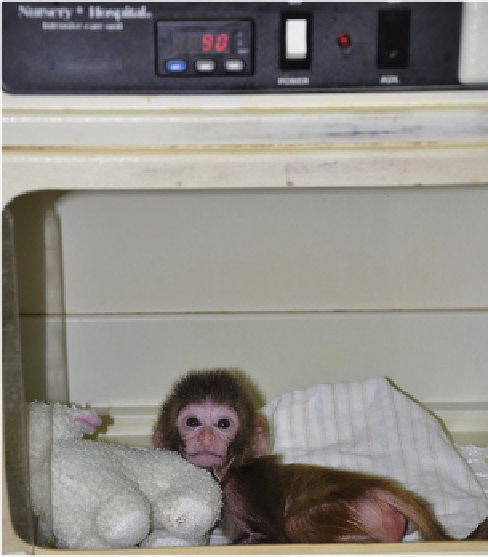Biomedical Engineering Reference
In-Depth Information
can occur in the postanesthetic period, even in appro-
priately starved animals, and the stimulation of pharyn-
geal tissue during extubation can predispose to vomiting
at this time. If vomiting occurs, the priority is to clear the
airway and a portable suction unit can be used in
conjunction with a ventral recumbency, head down
position to achieve this. The antiemetic metoclopromide
(
Table 17.1
) may be given 30 minutes before extubation
in order to reduce the risk of vomiting in the post-
anesthetic period.
and appears to provide a comfortable surface for the
animal. If such material is unavailable, towels or a blanket
should be used.
The environment should be kept quiet and bright lights
avoided particularly if there is a risk of epileptiform
activity, e.g. following craniotomy.
Monitoring
When monitoring the recovery of nonhuman primates, an
additional concern is ensuring the safety of staff, because
of the potentially serious consequences of being bitten by
a primate. One option is to use propofol sedation during
recovery so that animals can be allowed to return to
consciousness in a controlled manner. After completion of
surgery, the anesthetic is discontinued (e.g. sevoflurane)
and recovery of reflexes monitored. After return of the
pedal withdrawal response and increase in jaw tone, pro-
pofol can be administered intravenously to slightly
deepen anesthesia. Having produced a stable plane of light
anesthesia, the animal can either be extubated when jaw
tone returns or moved from the operating theater to its
recovery cage. Deep sedation or light anesthesia can be
continued with incremental doses of propofol, provided
respiration is monitored as there is a risk of hypo-
ventilation. The intravenous cannula can then be removed
and the animal allowed to recover completely. Recovery
from propofol is normally smooth and rapid and associ-
ated with a less prolonged period of ataxia than, for
example, isoflurane. Alternatively, in nonaggressive
animals, recovery can be allowed to proceed under direct
observation, with a heat pad or blanket in place, until
return of the righting reflex. It can then be transferred to
a warmed cage until fully recovered and able to make
coordinated movements.
Animals should be directly monitored until able to
maintain a patent airway (swallow and cough) and sit up.
Small amounts (5 ml) of water or dilute, noncitrus fruit
cordial (just enough to flavor the water) can be offered in
order to check that swallowing occurs. Thereafter the
monitoring plan will depend on the procedure carried out
and the possible adverse effects that may occur but should
continue until the animal has completely recovered from
the procedure. Where possible the use of cameras to enable
remote monitoring will eliminate the stress associated with
direct observation and may improve the quality and reli-
ability of observations.
Recovery Environment
During initial recovery from anesthesia, care should be
taken that respiratory obstruction does not occur and that
animals are kept warm. In most instances primates can be
allowed to recover in a pen or cage in a recovery room
(maintained at a high ambient temperature with supple-
mental heating of the cage as necessary). Smaller primates
such as marmosets and neonatal animals can be placed
inside an incubator (
Figure 17.8
). Care must be taken not to
overheat the animal, and where practicable a thermometer
should be placed next to the animal to record its surface
temperature.
Synthetic bedding with a texture similar to sheepskin
(Vetbed
) has proven particularly useful for all species of
primate. It is washable, autoclavable, extremely durable,
Feeding
Anesthetic agents may be associated with decreased food
intake in the postanesthetic period lasting for several
days (
Springer and Baker, 2007
). Offering a variety of
highly palatable food during this period is therefore
FIGURE 17.8
A neonatal macaque recovering from anesthesia in an
incubator, in order to maintain body temperature and promote
a rapid, smooth recovery.





